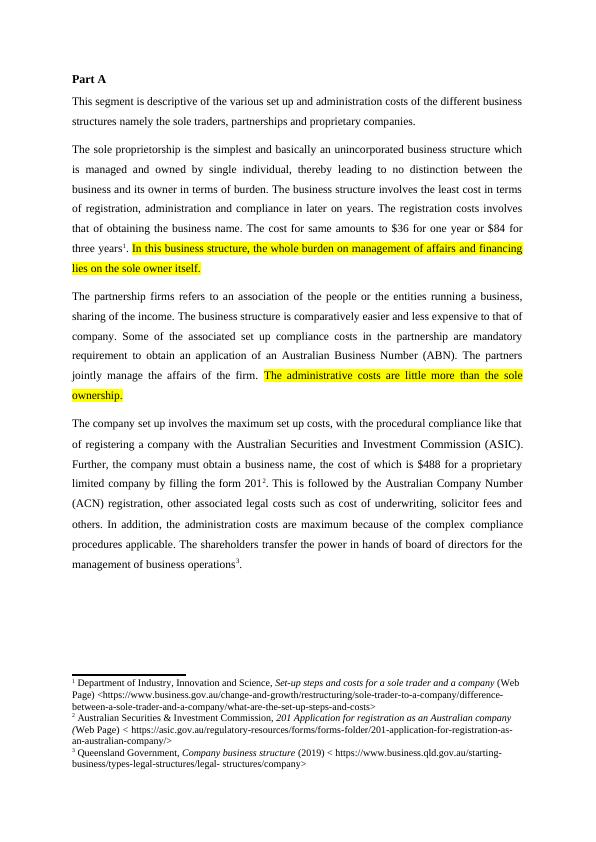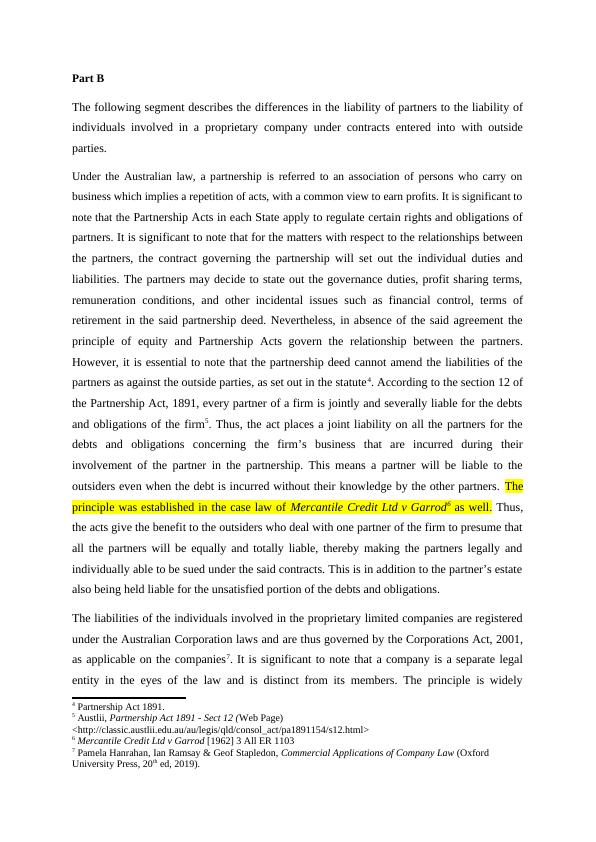Costs of Business Structures
Added on 2023-01-20
7 Pages2189 Words85 Views
CORPORATIONS and BUSINESS STRUCTURES
TERM 1
TERM 1

Part A
This segment is descriptive of the various set up and administration costs of the different business
structures namely the sole traders, partnerships and proprietary companies.
The sole proprietorship is the simplest and basically an unincorporated business structure which
is managed and owned by single individual, thereby leading to no distinction between the
business and its owner in terms of burden. The business structure involves the least cost in terms
of registration, administration and compliance in later on years. The registration costs involves
that of obtaining the business name. The cost for same amounts to $36 for one year or $84 for
three years1. In this business structure, the whole burden on management of affairs and financing
lies on the sole owner itself.
The partnership firms refers to an association of the people or the entities running a business,
sharing of the income. The business structure is comparatively easier and less expensive to that of
company. Some of the associated set up compliance costs in the partnership are mandatory
requirement to obtain an application of an Australian Business Number (ABN). The partners
jointly manage the affairs of the firm. The administrative costs are little more than the sole
ownership.
The company set up involves the maximum set up costs, with the procedural compliance like that
of registering a company with the Australian Securities and Investment Commission (ASIC).
Further, the company must obtain a business name, the cost of which is $488 for a proprietary
limited company by filling the form 2012. This is followed by the Australian Company Number
(ACN) registration, other associated legal costs such as cost of underwriting, solicitor fees and
others. In addition, the administration costs are maximum because of the complex compliance
procedures applicable. The shareholders transfer the power in hands of board of directors for the
management of business operations3.
1 Department of Industry, Innovation and Science, Set-up steps and costs for a sole trader and a company (Web
Page) <https://www.business.gov.au/change-and-growth/restructuring/sole-trader-to-a-company/difference-
between-a-sole-trader-and-a-company/what-are-the-set-up-steps-and-costs>
2 Australian Securities & Investment Commission, 201 Application for registration as an Australian company
(Web Page) < https://asic.gov.au/regulatory-resources/forms/forms-folder/201-application-for-registration-as-
an-australian-company/>
3 Queensland Government, Company business structure (2019) < https://www.business.qld.gov.au/starting-
business/types-legal-structures/legal- structures/company>
This segment is descriptive of the various set up and administration costs of the different business
structures namely the sole traders, partnerships and proprietary companies.
The sole proprietorship is the simplest and basically an unincorporated business structure which
is managed and owned by single individual, thereby leading to no distinction between the
business and its owner in terms of burden. The business structure involves the least cost in terms
of registration, administration and compliance in later on years. The registration costs involves
that of obtaining the business name. The cost for same amounts to $36 for one year or $84 for
three years1. In this business structure, the whole burden on management of affairs and financing
lies on the sole owner itself.
The partnership firms refers to an association of the people or the entities running a business,
sharing of the income. The business structure is comparatively easier and less expensive to that of
company. Some of the associated set up compliance costs in the partnership are mandatory
requirement to obtain an application of an Australian Business Number (ABN). The partners
jointly manage the affairs of the firm. The administrative costs are little more than the sole
ownership.
The company set up involves the maximum set up costs, with the procedural compliance like that
of registering a company with the Australian Securities and Investment Commission (ASIC).
Further, the company must obtain a business name, the cost of which is $488 for a proprietary
limited company by filling the form 2012. This is followed by the Australian Company Number
(ACN) registration, other associated legal costs such as cost of underwriting, solicitor fees and
others. In addition, the administration costs are maximum because of the complex compliance
procedures applicable. The shareholders transfer the power in hands of board of directors for the
management of business operations3.
1 Department of Industry, Innovation and Science, Set-up steps and costs for a sole trader and a company (Web
Page) <https://www.business.gov.au/change-and-growth/restructuring/sole-trader-to-a-company/difference-
between-a-sole-trader-and-a-company/what-are-the-set-up-steps-and-costs>
2 Australian Securities & Investment Commission, 201 Application for registration as an Australian company
(Web Page) < https://asic.gov.au/regulatory-resources/forms/forms-folder/201-application-for-registration-as-
an-australian-company/>
3 Queensland Government, Company business structure (2019) < https://www.business.qld.gov.au/starting-
business/types-legal-structures/legal- structures/company>

Part B
The following segment describes the differences in the liability of partners to the liability of
individuals involved in a proprietary company under contracts entered into with outside
parties.
Under the Australian law, a partnership is referred to an association of persons who carry on
business which implies a repetition of acts, with a common view to earn profits. It is significant to
note that the Partnership Acts in each State apply to regulate certain rights and obligations of
partners. It is significant to note that for the matters with respect to the relationships between
the partners, the contract governing the partnership will set out the individual duties and
liabilities. The partners may decide to state out the governance duties, profit sharing terms,
remuneration conditions, and other incidental issues such as financial control, terms of
retirement in the said partnership deed. Nevertheless, in absence of the said agreement the
principle of equity and Partnership Acts govern the relationship between the partners.
However, it is essential to note that the partnership deed cannot amend the liabilities of the
partners as against the outside parties, as set out in the statute4. According to the section 12 of
the Partnership Act, 1891, every partner of a firm is jointly and severally liable for the debts
and obligations of the firm5. Thus, the act places a joint liability on all the partners for the
debts and obligations concerning the firm’s business that are incurred during their
involvement of the partner in the partnership. This means a partner will be liable to the
outsiders even when the debt is incurred without their knowledge by the other partners. The
principle was established in the case law of Mercantile Credit Ltd v Garrod6 as well. Thus,
the acts give the benefit to the outsiders who deal with one partner of the firm to presume that
all the partners will be equally and totally liable, thereby making the partners legally and
individually able to be sued under the said contracts. This is in addition to the partner’s estate
also being held liable for the unsatisfied portion of the debts and obligations.
The liabilities of the individuals involved in the proprietary limited companies are registered
under the Australian Corporation laws and are thus governed by the Corporations Act, 2001,
as applicable on the companies7. It is significant to note that a company is a separate legal
entity in the eyes of the law and is distinct from its members. The principle is widely
4 Partnership Act 1891.
5 Austlii, Partnership Act 1891 - Sect 12 (Web Page)
<http://classic.austlii.edu.au/au/legis/qld/consol_act/pa1891154/s12.html>
6 Mercantile Credit Ltd v Garrod [1962] 3 All ER 1103
7 Pamela Hanrahan, Ian Ramsay & Geof Stapledon, Commercial Applications of Company Law (Oxford
University Press, 20th ed, 2019).
The following segment describes the differences in the liability of partners to the liability of
individuals involved in a proprietary company under contracts entered into with outside
parties.
Under the Australian law, a partnership is referred to an association of persons who carry on
business which implies a repetition of acts, with a common view to earn profits. It is significant to
note that the Partnership Acts in each State apply to regulate certain rights and obligations of
partners. It is significant to note that for the matters with respect to the relationships between
the partners, the contract governing the partnership will set out the individual duties and
liabilities. The partners may decide to state out the governance duties, profit sharing terms,
remuneration conditions, and other incidental issues such as financial control, terms of
retirement in the said partnership deed. Nevertheless, in absence of the said agreement the
principle of equity and Partnership Acts govern the relationship between the partners.
However, it is essential to note that the partnership deed cannot amend the liabilities of the
partners as against the outside parties, as set out in the statute4. According to the section 12 of
the Partnership Act, 1891, every partner of a firm is jointly and severally liable for the debts
and obligations of the firm5. Thus, the act places a joint liability on all the partners for the
debts and obligations concerning the firm’s business that are incurred during their
involvement of the partner in the partnership. This means a partner will be liable to the
outsiders even when the debt is incurred without their knowledge by the other partners. The
principle was established in the case law of Mercantile Credit Ltd v Garrod6 as well. Thus,
the acts give the benefit to the outsiders who deal with one partner of the firm to presume that
all the partners will be equally and totally liable, thereby making the partners legally and
individually able to be sued under the said contracts. This is in addition to the partner’s estate
also being held liable for the unsatisfied portion of the debts and obligations.
The liabilities of the individuals involved in the proprietary limited companies are registered
under the Australian Corporation laws and are thus governed by the Corporations Act, 2001,
as applicable on the companies7. It is significant to note that a company is a separate legal
entity in the eyes of the law and is distinct from its members. The principle is widely
4 Partnership Act 1891.
5 Austlii, Partnership Act 1891 - Sect 12 (Web Page)
<http://classic.austlii.edu.au/au/legis/qld/consol_act/pa1891154/s12.html>
6 Mercantile Credit Ltd v Garrod [1962] 3 All ER 1103
7 Pamela Hanrahan, Ian Ramsay & Geof Stapledon, Commercial Applications of Company Law (Oxford
University Press, 20th ed, 2019).

End of preview
Want to access all the pages? Upload your documents or become a member.
Related Documents
Corporations and Business Structureslg...
|6
|2102
|41
Company and Association Lawlg...
|12
|2959
|24
Comparison of Set Up and Administrative Costs in Different Business Structureslg...
|7
|2334
|25
BUSINESS AND CORPORATION LAW.lg...
|10
|2673
|98
Corporations and Business Structureslg...
|8
|2430
|49
Corporations and Business Structurelg...
|13
|3732
|97
